On July 30, 2015, Drew Hirshfeld was sworn in as the new Commissioner for Patents. Hirshfeld replace Margaret “Peggy” Focarino, who has just joined Oblon as a Senior Patent Advisor.
Prior to taking the helm of patent operations as Commissioner for Patents, Hirshfeld served as Deputy Commissioner for Patent Examination Policy. Even before assuming the position of Deputy Commissioner, Hirshfeld was no stranger to senior management, having served two years as the USPTO Chief of Staff for David Kappos. He also served as a Supervisory Patent Examiner as well as a Group Director of Technology Center 2100, overseeing Computer Networking and Database workgroups.
I have wanted to get Hirshfeld on the record for some time now, but for one reason or another the timing never worked out. As soon as I learned that he was appointed as the new Commissioner for Patents I acted quickly to secure an interview, which Hirshfeld graciously agreed to only days after he was appointed Commissioner.
On August 10 2015, I had the opportunity to interview Commissioner Hirshfeld in his 10th floor office in the Madison Building on the Alexandria, Virginia campus of the USPTO. During our interview we discussed his path from new examiner in 1994 to Commissioner. We also discussed his time as an examiner, the importance of stakeholders communicating with the Patent Office, the Patent Quality Initiative, maintaining a proper work/family balance, and a handful of fun, “get to know you” questions.
Without further ado, here is part 1 of my 3 part interview with Drew Hirshfeld.
[Interview-1]
QUINN: Thank you, Commissioner, for taking the time to chat with me. I’ve wanted to get you on the record for a long time and with you just becoming the new commissioner, what better time? So, you’ve been commissioner now a little bit over 10 days, right?
HIRSHFELD: Correct.
QUINN: How did everything happen? It seemed to happen relatively quickly because Commissioner Focarino announced that she was retiring and left at the end of June, and then before July was out you were being sworn in.
HIRSHFELD: Right. When Peggy announced her retirement, Michelle Lee asked interested candidates to submit their names to be considered. And, of course, I put my name in for consideration.
QUINN: And the process just seemed to happen relatively quickly?
HIRSHFELD: Sure. There was an interview process. I know they wanted to go quickly in order to not have a vacant spot for the commissioner as we move forward.
QUINN: Yes. So you’re a career person here at the Patent Office.
HIRSHFELD: Correct. All but one year of my working career.
QUINN: OK. Since you brought it up, what did you do during that one year?
HIRSHFELD: Well, I actually spent a year as a computer programmer right after undergraduate school. And then I went to law school and then I actually spent another year in a law firm after law school prior to coming to the PTO. So it was actually two years, but since law school there’s been only one year of my career that’s not been spent at the PTO.
QUINN: You’ve been here over 20 years now, correct?
HIRSHFELD: Yes. Almost 21.
QUINN: So when you first got here on that first day and you looked around, and I guess it wasn’t on this campus you were over at the old Patent Office campus first, but in any event, when you looked around and you didn’t know where you were going and you were trying to meet everyone and figure out what you needed to be doing, did you ever dream that you might be sitting here on the 10th floor as commissioner?
HIRSHFELD: I didn’t at that point think about I would be here sitting as commissioner and at that point I actually remember the interview that I had when I wanted to become an examiner. I was asked the question about what I saw as my career path, and while I thought that there was a good chance I would stay at the PTO I didn’t at that point envision being commissioner.
QUINN: At what point in time did that change? You’ve been around on the 10th floor for a while now. You were appointed as deputy commissioner and then before you ever became deputy you were taken away by Director Kappos to be his Chief of Staff. So it seems like you’ve been a person on the move and in demand around here for a while.
HIRSHFELD: I think when I first became a group director was the first chance that I thought I would one day, if all went very well, be at the deputy commissioner level or even potentially Commissioner. But those were small and fleeting thoughts back at that point.
QUINN: Walk us through your time here at the Patent Office. At one point you were the newest examiner when you started back in 1994, was it?
HIRSHFELD: Yes, 1994 is when I started as an examiner.
QUINN: And you were examining where?
HIRSHFELD: And I was examining in multiple areas, including geometric instruments. So anything that measured a distance, you know, it could be something simple like a ruler or complex like a coordinate, a three dimensional coordinate measuring machine. And I was also in some of the signals and indicating arts. And I’m going to apologize, Gene, I don’t have the exact years for you.
QUINN: No, that’s fine.
HIRSHFELD: But then I became a supervisory patent examiner (SPE) and ended up overseeing some of the printing technologies. And then Group Director in TC 2100. I also did a detail, while I was a SPE, to the Office of General Law. I worked on all the human relations issues and that was a very valuable time of my career. So then I spent about eight months as a group director and as I was getting settled in, that’s when Peggy first asked me to act for John Love, who had retired as Deputy Commissioner for Patent Examination Policy. And that was really the first time I started to think OK, you know, I do have potentially the opportunity to be a commissioner one day.
QUINN: I realize you’ve only been on the job for a few days now but is it what you expected it would be so far?
HIRSHFELD: It really is what I expected. The way Peggy Focarino ran Patents and worked with her deputies, she’s very open and we were involved in a lot of decisions and not necessarily we were all making decisions, but we were all aware of the issues. So for me there was really nothing very surprising that has come in in the short time I’ve been in this job. Also when I was chief of staff for two years, I got to see how the whole entire agency was run by Dave Kappos, and got to see the bigger pictures issues, budget issues, etc.. So there’s really nothing that has been a surprise to me.
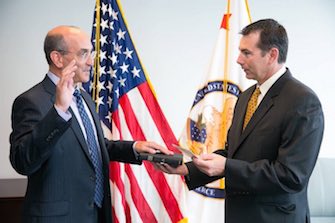
Drew Hirshfeld (left) sworn in as new Commissioner for Patents by USPTO Deputy Director Russ Slifer.
QUINN: That’s the one thing that interests me about the senior management team, because you all have your own title, like you were deputy commissioner for patent examination policy and Bruce (Kisliuk) was administration, right? And Andy is still operations. But it seemed like you guys were all interchangeable. With the commissioner and the deputies it seemed like it was always “all hands on deck,” and it’s been that for a while here, correct?
HIRSHFELD: Absolutely. As a matter of fact, I start every morning with a meeting with the deputies. And so we meet every single day as a group and go over all the issues that we have on the table so we can be there to help each other. There’s a lot of crosscutting issues that we need to be aware of so we are really managing as one big group. And then in addition to that, I have individual meetings with each of the deputies as we go forward, so there’s a lot of interplay and interaction with the deputies. That’s the way it was when I was a deputy and I plan on continuing that and even increasing it if I can.
QUINN: OK. So I guess before we transition into what substantively is on your plate, one of the questions I have is who is going to become the new Drew, the new deputy for patent examination policy? I ask because that has historically been a pretty important position here and has launched a lot of careers, including yours.
HIRSHFELD: Sure.
QUINN: So where do you stand in that search?
HIRSHFELD: Vacancy announcements for these positions have been posted online where people can apply, and we will go through the interview process to fill that on a permanent basis. Right now in the interim period, Bob Bahr, who was acting in that role for the two-year stint when I was chief of staff, is acting deputy commissioner for patent examination policy.
QUINN: Great. So now, Commissioner, when you walked in the door and now you’re not the deputy, you’re the one who gets the final vote on the day, too — well, maybe I should take a step back and ask the question. The way I’ve observed the Office is obviously the director and deputy directors run things, but that the commissioner is more like a chief operating officer in a lot of ways and the director would be the CEO and maybe the deputy director like the president, to compare to the private sector.
HIRSHFELD: Yes.
QUINN: So now that you’re COO of the patent operation, which is over 90% what happens here. What things were left on your desk that are most pressing?
HIRSHFELD: Well, a number of people have asked me what’s changing or what focus do you have that’s different? And really the big goals for me are the same as they were with Peggy. And that, of course, at the start is the Enhanced Patent Quality Initiative. And so for us, continuing to move forward with the quality initiative in the most effective way is primary job one. Also, again nothing new to me, is exactly how we’re going to move forward with the quality initiative, and being very open and transparent and making sure that we’re listening to the public, our examiners, we’re engaging with the unions, etc. That openness and collaboration is very important to me, as it was to Peggy before me, and all my deputies.
QUINN: Let’s take a step back and talk about the quality. I’m sure you’ve heard this – a lot of people hear ‘quality initiative’ and it’s like blah-blah-blah-blah. It’s just a catch phrase, what does it really mean? There’s a feeling by some that they don’t really know what it means other than perhaps it is some kind of anti-patent sentiment. Now that’s not the feeling that I get around here, but it is a concern that I hear outside the building. And so I wonder whether you tell us more substantively about the quality initiative and what would you say to those people who do have the fear that in this climate, which is really unfortunately anti-patent in at least some ways, that “patent quality” is code for we just have to issue fewer patents.
HIRSHFELD: A few things. Although you caught my attention with quality means we issue a few patents. So let me address that first. We’ve always focused on quality as far as I’ve been here. What we have been asked to do in recent years is ask how can we take a more “out of the box” approach to quality, right? Is there anything that we could be doing with the goal of continuous improvement? And so to me that’s an absolutely wonderful position to be in for anybody asking how can you do your job better. And so I don’t look at quality as saying we want to issue more patents or less patents, we want to do a better job, a good job in the process as we’re moving forward. Things like clarity of the record. That does not mean we’re going to issue more or less, it means that we’re going to take extra steps to make sure we’re on the same page as the applicant. Or make sure we’re creating a good record so that a third party down the road can evaluate the application history, the prosecution history and tell exactly what took place. Certainly there is not a sentiment to try to reject more or less. Our goal is to do what the courts are asking us to do but we want to make sure that we’re thinking about all the ways we can do that in the most effective, efficient and clear way.
QUINN: I think that’s a great answer. What has run through my mind is it’s not like you guys here haven’t tried to provide quality. It’s not like that there has been some low threshold of quality that has been acceptable. I know that there will always be things that fall through the cracks just like anywhere, but I think what’s driving the concern about the quality initiative is uncertainty with respect to how things are going to be different. Making the record clear is certainly one thing and I don’t know that there’s a question here really, so bear with me for a minute and I’ll get to the point. I continue to think when I teach this issue is if you compare patents that were filed 50 years ago versus the ones today, or even 20 years ago versus the ones issued today, the patents today are much longer, much more detailed, much more complex and I have to think that this has made your job more difficult.
HIRSHFELD: Well, I think that there have been technology changes and advancements and more prior art for examiners to look at. But of course we have tools that help us do that. But the quality initiative really goes to customer service, right? Openness, transparency, tools that we have for examiners, etc. So, it really is the whole game. I’m not sure if I answered your question.
QUINN: I think that that does because quality means a lot of things. And it’s a term that could mean a lot of different things to a lot of different people. And I guess you’re still in the process of sifting through comments and figuring out substantively what you’re going to do, right? But can you tell us anything about where you see this all going? When is it going to take a little bit more of a concrete format?
HIRSHFELD: As you said, weare in the process of going through all the comments we received and I believe there were over 1100 comments that we got back. Now, those were in the form of comments to our Federal Register notice and comments that were made verbally at the two-day summit we had. And so what we’re doing at this point is consolidating those comments and grouping them so we can make the most educated decision about how we want to move forward. And then once we have a path forward, we’ll of course be very open with that, and we need to work with our employees, the public and the unions, etc. And so we’re still at the beginning cusp so I don’t really have a timeframe for you, but we’re in the process of now starting to put timelines and timeframes for potential changes.
QUINN: And then in terms of the openness, and you just brought that up again. It has always struck me that you really are concerned about people’s experience dealing with the Patent Office and really want to hear those stories, both good and bad, so that you can make an improvement. Is that going to be a continued push for you now that you’re in the decision making chair?
HIRSHFELD: 100% yes, absolutely. And you’ve asked a little bit about my first 10 days. We’ve already had numerous discussions with my management team about openness and transparency, just things that are important to me and that’s certainly at the top of the list.
QUINN: So now how do you get that to trickle down into the patent bar? How do you get people to trust that you really are interested in knowing what their experiences are?
HIRSHFELD: Well, I think the proof is in the details.We need to be able to take the information from people, be able to have that open conversation, show people we are listening and that we are taking appropriate steps. It doesn’t mean when you listen to everybody you do what people want all the time. You don’t know. You have to weigh and make the right decision, but people want to be heard, people want to know you considered what they’ve said. And as long as you are setting the example of really listening and really making educated decisions based on the feedback, we’re all in a better place for it.
QUINN: I agree with that. I hear a lot of stories, and I always tell people they need to speak to the Patent Office to tell you what they’ve told me. And usually I get a response something like – “oh, no, no we would never do that” or “the client won’t let us do that,” or “senior management at the firm would never let us do that.” But the system can’t get better if the people who want to make a difference, want to make it more open and transparent and fix problems don’t know what people are really experiencing. It’s like ships passing in the night, if you don’t know about it you can’t do anything about it.
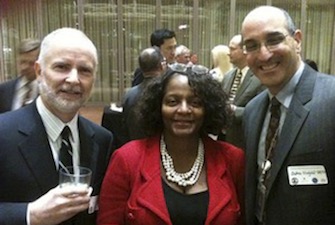
Hirshfeld (right) with then Deputy Director Sharon Barner and John White (left) at Bayh Dole 30 celebration at the PTO.
HIRSHFELD: Right. And that’s true at all levels. And I’m going get back to clarity of the record and one of our goals there is just to make sure that the applicant and the examiner are on the same page as they’re proceeding in prosecution. It’s no different if you take that to a much higher level where we’re talking about a quality initiative in general and we’re listening to the public. So, to me it’s the same, let’s all understand each other; we may agree or disagree, but we need to start with a common understanding.
QUINN: Well, that’s interesting you say that because maybe we could talk about that because I think the statistics show that those people that engage in the early interview program get on the same page with the examiner much more quickly. And there’s a higher overall allowance rate and a better prosecution. So it always interests to me as to why isn’t everybody using that? That’s still the case, right? I mean early interviews are a great way to get on the same page, correct?
HIRSHFELD: Absolutely.
QUINN: So are you continuing to see more people use that or is it leveling off with the only the usual suspects using it?
HIRSHFELD: I only have an anecdotal answer here at this point. But I am hearing more people wanting to, or talking about the benefits of interviews. I know I’ve had companies in here that are telling me they’re deciding to interview all of their cases. And then anecdotally again, I’ve just got a lot of feedback, very, very positive. We do know that when there is an interview, people have a higher allowance rate. And so I do think people are learning about it and continuing to learn about it and we’ll continue to push it from our end.
QUINN: These are the things that you were left with and now you’re picking up and running forward with, but I suspect that there are probably a few initiatives that you have in mind that you might like to pursue. What might those be?
HIRSHFELD: Well, I do think, sincerely, that my initiatives are very similar to what we’ve been working. It’s easy to say when you have a quality initiative where you haven’t figured out the exact path. I do have thoughts on how we should proceed under the quality initiative that fit under the big umbrella of what we’ve been trying to achieve. But absolutely, I think we need to increase examiner training, examiner training on a lot of the statutes, you know 112, 103, etc. We’ve been doing that, however, over recent years, and to me we should continue to do that. But there’s nothing really that stands out as saying this is Drew Hirshfeld’s agenda that’s very different from what has taken place. I’m really trying to stick to the path that we’ve already gone down, the path Michelle Lee has put us on. I think it’s a wonderful path, and it’s quite frankly one of the reasons I really wanted to be commissioner at this point. So really I’m trying to stick to that path.
CLICK HERE to CONTINUE READING… In the next installment of the interview wrap up our discussion of the Patent Quality Initiative and what it may look like, as well as 101 guidance from the Patent Office.

![[IPWatchdog Logo]](https://ipwatchdog.com/wp-content/themes/IPWatchdog%20-%202023/assets/images/temp/logo-small@2x.png)

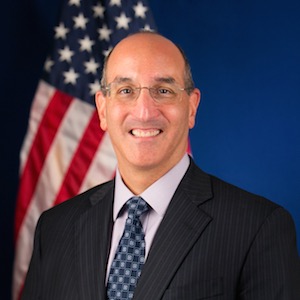
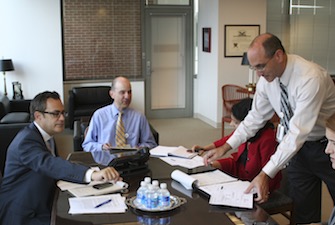
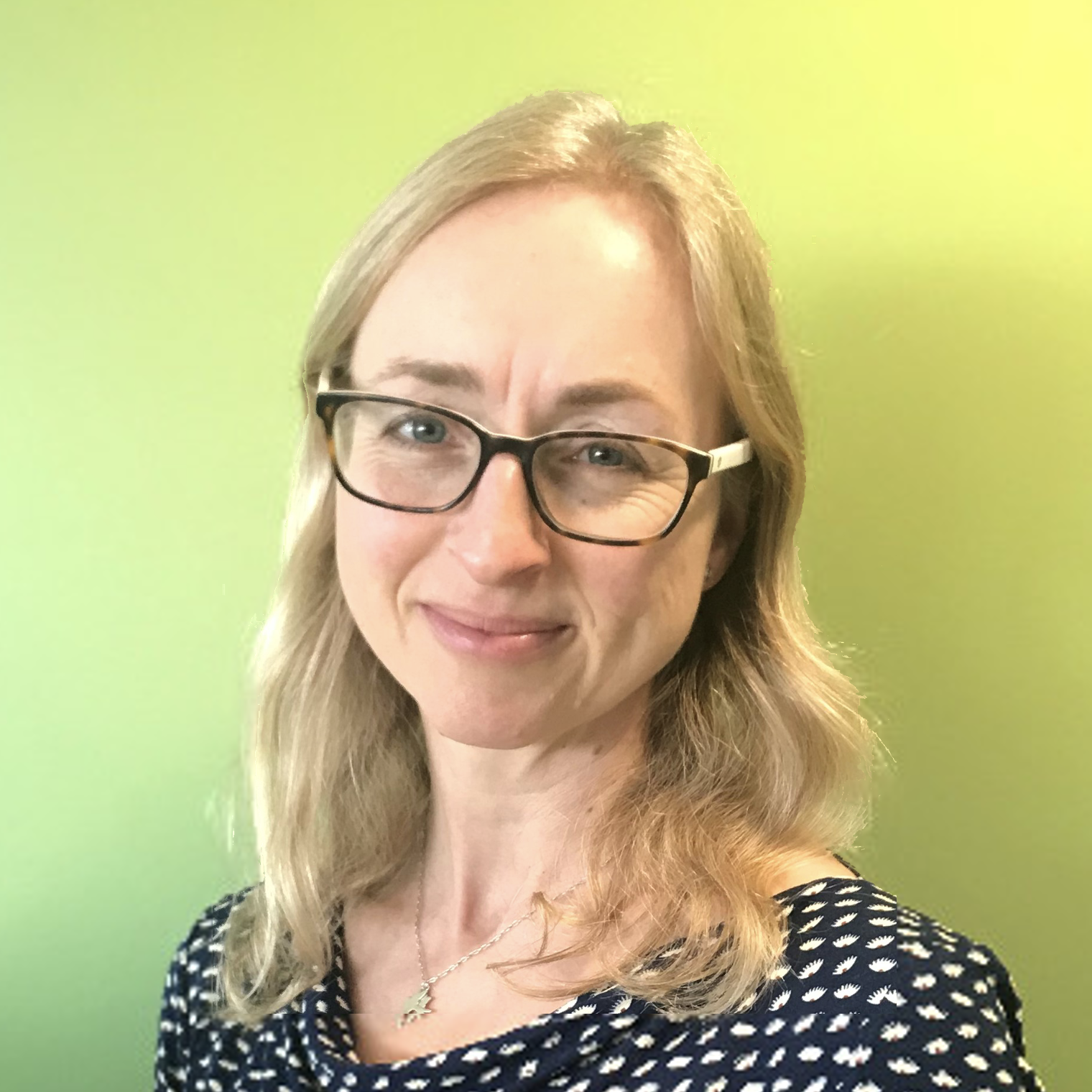
![[Advertisement]](https://ipwatchdog.com/wp-content/uploads/2024/04/Artificial-Intelligence-2024-REPLAY-sidebar-700x500-corrected.jpg)
![[Advertisement]](https://ipwatchdog.com/wp-content/uploads/2024/04/Patent-Litigation-Masters-2024-sidebar-700x500-1.jpg)

![[Advertisement]](https://ipwatchdog.com/wp-content/uploads/2021/12/WEBINAR-336-x-280-px.png)
![[Advertisement]](https://ipwatchdog.com/wp-content/uploads/2021/12/2021-Patent-Practice-on-Demand-recorded-Feb-2021-336-x-280.jpg)
![[Advertisement]](https://ipwatchdog.com/wp-content/uploads/2021/12/Ad-4-The-Invent-Patent-System™.png)






Join the Discussion
6 comments so far.
Eric Berend
September 22, 2015 07:39 amThere is much of the attitude of a lifelong bureaucrat expressed here; albeit at least; having been in the same agency throughout his career. it seems there isn’t much here to fire the imagination, beyond emphasizing a few (possibly) beneficial details.
His boss Ms. Lee, was at Google before she was appointed head of the USPTO. Nothing this career bureaucrat has to say, seems to be anything different than that of the very same agency that is currently terrorizing genuine inventors with the inane Leahy-AIA triple-headed monster (a veritable Cerberus) of Inter Partes Review, Broadest Possible Interpretation and Post-Grant Review.
However good Mr. Hirshfeld’s own intent may be, he is not one of the “powers that be” in this situation; in truth I see the value of this commentary as only modestly better than ‘fiddling while “Rome” (e.g., U.S. patent jurisprudence) burns’.
Eric Berend
September 22, 2015 07:20 am@ 1. : patent leather, I would agree. I have seen other references to USPTO patent examiners fearing such reviews; in a couple of those, the expert involved expressed a similar perception.
@ 3. : Mr. Morgan, I must respectfully agree with ‘Anon’ of #4., when he notes that you more often express the viewpoint of one who is constrained by negativity regarding patent law and its appurtenant rights and limitations. As an inventor, I think it is more productive and speaks to a better potential of the situation, to look towards more positive possibilities and interpretations than those usually espoused in your comments.
Anon
September 16, 2015 08:20 amMr. Morgan,
Your “endless late claiming” has forgotten a rather important limitation: no new matter.
May I remind you to check your bias at the door? Often (rather too often), your posts are written from the mindset of one looking to defeat granted patent rights instead of a balanced mindset of recognizing why we have a patent system in the first place.
This lessens the impact of what you have to offer – we already have far too many nay-sayers.
Paul F. Morgan
September 15, 2015 10:45 amI hope that Dave Kappo’s initiative to address “submarine” application will continue. A very small investment in PTO supervision and examiner time can yield great public benefits. Especially since there is no U.S. restraint, other than prosecution laches and enforcement of proper examination in claimed priority date order, on endless “late claiming.”
Edward Heller
September 15, 2015 08:51 am“But the quality initiative really goes to customer service, right?”
Disturbing.
patent leather
September 14, 2015 03:56 pmcongrats, Drew.When you were Deputy Commissioner for Patent Examination Policy, I called your office with a question about a particular case and to my surprise you actually returned my call! Not trying to raise old wounds, but when Doll was commissioner his plan to improve quality (at least this is my understanding) was the “second set of eyes” which reviewed allowed applications, which caused many examiners to fear allowing anything (since there was no review of rejected cases). I think quality reviews are good but please make sure both allowances and rejections are both reviewed equally so examiners are motivated to examine carefully and nothing else.